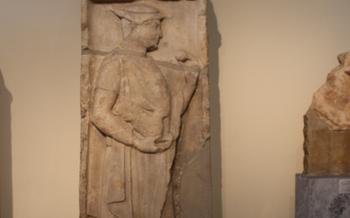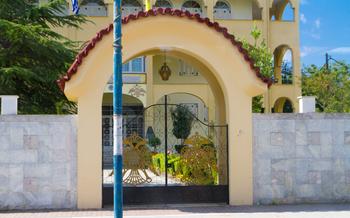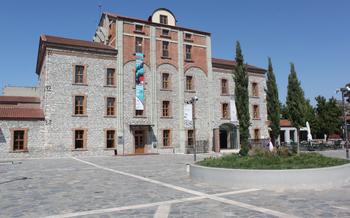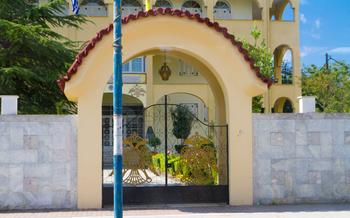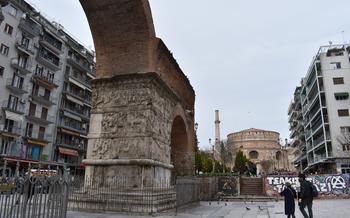
Larissa Imperial Baths
- Unveiling the Ancient Baths: A Journey Through Time
- Exploring the Architectural Marvels
- Experiencing the Bathing Rituals
- A Glimpse into the Roman Lifestyle
- Preservation and Restoration Efforts
- Interactive Exhibits and Displays
- Surrounding Attractions and Activities
- Unveiling the Ancient Aqueducts
- Thermal Springs and Healing Waters
- Ancient Art and Mosaics
- Role of the Baths in Religious Rituals
- Bathing Etiquette and Social Norms
- Archaeological Discoveries and Ongoing Research
- Insider Tip: Hidden Gems and Local Secrets
Unveiling the Ancient Baths: A Journey Through Time
History and significance of the Larissa Imperial Baths
Journey back in time to the heart of ancient Greece, where the Larissa Imperial Baths stand as a testament to the grandeur of Roman civilization. Built during the reign of Emperor Hadrian in the 2nd century AD, these lavish baths were once the epicenter of social, cultural, and hygienic life for the people of Larissa. The baths served as a sanctuary for relaxation, rejuvenation, and community, offering a glimpse into the remarkable engineering, architectural prowess, and bathing practices of the Roman Empire.
Location and accessibility of the site
Situated in the heart of the modern city of Larissa, the Larissa Imperial Baths are easily accessible to visitors. Located near the picturesque Alkazar Park and the banks of the Pineios River, the site offers a serene retreat from the hustle and bustle of city life. The baths are well-signposted and accessible by foot, bicycle, or public transportation, making them a convenient destination for history buffs and curious travelers alike.
Importance of the baths in ancient Roman culture
In ancient Rome, baths played a crucial role in the daily lives of citizens. They were not merely places for cleansing but also served as social hubs, centers of entertainment, and venues for philosophical discussions. The baths were considered so important that they were often constructed on a grand scale, with elaborate designs and luxurious amenities. The Larissa Imperial Baths exemplify this grandeur, showcasing the Romans' dedication to hygiene, leisure, and community well-being.
The role of the baths in the daily lives of the Larisseans
For the people of ancient Larissa, the Imperial Baths were an integral part of their daily routine. They visited the baths not only to cleanse their bodies but also to socialize, relax, and engage in various recreational activities. The baths were divided into separate sections for men and women, allowing them to bathe and socialize separately. Wealthy citizens often brought their slaves to assist them with bathing and other tasks, while public baths were available for those of more modest means.
Exploring the Architectural Marvels
The Larissa Imperial Baths stand as a testament to the ingenuity and architectural prowess of the ancient Romans. The complex boasts unique features that set it apart from other Roman baths, showcasing the city's grandeur and importance.
The baths were strategically located in the heart of the city, near the ancient agora, making them easily accessible to the Larisseans. The complex was designed with meticulous precision, featuring a symmetrical layout that mirrored the Roman passion for order and symmetry.
Upon entering the baths, visitors would be greeted by a series of chambers, each dedicated to a specific function. The frigidarium, or cold room, served as the initial cleansing space, featuring a large plunge pool filled with cool water. The tepidarium, or warm room, provided a transition zone, preparing the body for the intense heat of the caldarium.
The caldarium, or hot room, was the centerpiece of the bathing complex. This chamber was designed to induce sweating and promote relaxation. It featured a raised platform with individual bathing basins, allowing bathers to soak in hot water and enjoy the therapeutic benefits of steam and heat.
The architectural elements of the Larissa Imperial Baths are equally impressive. The use of marble, columns, and intricate mosaic tiles adds an air of opulence and grandeur to the complex. The vaulted ceilings and large windows not only provided ample natural light but also enhanced the sense of spaciousness and grandeur.
Overall, the Larissa Imperial Baths represent a remarkable fusion of functionality and aesthetics, showcasing the architectural ingenuity of the ancient Romans. Exploring this well-preserved site allows visitors to step back in time and experience the grandeur of a once-thriving Roman city.
Experiencing the Bathing Rituals
The ancient Roman baths were not merely places for cleansing; they held deep social and cultural significance. In Larissa, the Imperial Baths played a crucial role in the daily lives of the city's inhabitants. Bathing was a ritual that encompassed health, hygiene, and social interaction.
The bathing process began with a visit to the apodyterium, the dressing room where bathers undressed and left their belongings. From there, they proceeded to the frigidarium, the cold room. A plunge into the frigidarium's icy waters was believed to stimulate circulation and invigorate the body.
Next came the tepidarium, the warm room. Here, bathers could relax in a comfortably heated environment, preparing their bodies for the intense heat of the caldarium, the hot room. The caldarium was the heart of the bathing experience. Its steamy vapors and high temperatures were believed to have therapeutic effects, easing muscle tension and promoting relaxation.
After sweating profusely in the caldarium, bathers returned to the tepidarium to cool down gradually. They would then scrape off dirt and impurities from their skin using a strigil, a curved metal instrument. Finally, they applied oils and scents to their bodies, leaving them feeling refreshed and rejuvenated.
Bathing rituals were not just about physical cleanliness; they were also deeply social occasions. The baths were a place where people from all walks of life could come together, socialize, and exchange news. Friends and acquaintances would often meet in the baths to discuss politics, philosophy, or the latest gossip.
The use of oils, scents, and strigils was not merely for hygiene purposes but also had cultural significance. Oils and scents were believed to have therapeutic and beautifying properties, while the use of strigils symbolized the removal of impurities, both physical and spiritual.
The bathing rituals in the Larissa Imperial Baths were an integral part of Roman culture. They were a time for relaxation, socialization, and purification, and they played a vital role in the daily lives of the city's inhabitants.
A Glimpse into the Roman Lifestyle
In the Roman Empire, bathing was regarded as an integral aspect of maintaining optimal health and well-being, and it played a crucial role in Roman culture and society. The Larissa Imperial Baths served as a significant social hub, providing a space for individuals to socialize, relax, and rejuvenate. Bathing was seen as a communal activity, and the baths were designed to accommodate a diverse range of social interactions.
The Romans placed great importance on the concept of "otium," which refers to a state of leisure and relaxation. Bathing was considered an ideal way to indulge in otium and escape the demands of daily life. While bathing, individuals could engage in leisurely activities such as reading, playing games, or simply conversing with friends and acquaintances. The baths also provided a space for networking and forming social connections, contributing to the vibrant social fabric of Roman society.
Various recreational activities and games were associated with the baths. Swimming pools were a popular feature, allowing individuals to enjoy the refreshing waters and engage in aquatic sports. Other games included ball games, which were played in designated areas within the bath complex. These activities added an element of fun and camaraderie to the bathing experience, further enhancing its social appeal.
Preservation and Restoration Efforts
The passage of time, natural elements, and human activities have taken their toll on the Larissa Imperial Baths, posing significant challenges to their preservation. Recognizing the immense historical and cultural value of the site, extensive efforts have been undertaken to protect and restore this architectural marvel.
Conservation techniques employed at the Larissa Imperial Baths include structural reinforcement, stone cleaning, and the use of specialized materials to repair damaged elements. Archaeological research and documentation play a crucial role in understanding the original design and function of the baths, guiding restoration efforts and ensuring the authenticity of the site.
The ongoing dedication to preserving the Larissa Imperial Baths ensures their longevity and allows future generations to appreciate this remarkable testament to ancient Roman engineering and bathing culture. Archaeological research continues to uncover new insights into the history and significance of the baths, contributing to our understanding of this iconic monument.
Interactive Exhibits and Displays
The Larissa Imperial Baths have embraced technology to enhance the visitor experience and bring the ancient world to life. Interactive displays and exhibits offer a multisensory journey through time, allowing visitors to engage with the history and functions of the baths in a dynamic way.
Virtual reality experiences transport visitors back in time, immersing them in the sights and sounds of the ancient bathing rituals. They can experience the bustling atmosphere of the baths, witness the process of bathing, and even interact with virtual characters who guide them through the complex.
Multilingual audio guides provide a comprehensive understanding of the site's history, architecture, and cultural significance. Visitors can choose from a variety of languages to ensure they fully grasp the nuances of the ancient Roman bathing experience.
These interactive elements not only enhance the visitor experience but also contribute to the preservation and promotion of the Larissa Imperial Baths. By utilizing technology, the site becomes more accessible and engaging to a wider audience, fostering a deeper appreciation for its cultural heritage.
Surrounding Attractions and Activities
Situated in the heart of Thessaly, Larissa offers a wealth of attractions beyond the Imperial Baths. The Archaeological Museum of Larissa showcases a stunning collection of artifacts from the city's rich past. Marvel at ancient pottery, sculptures, and mosaics that bring to life the civilization that once thrived here.
The Old Town of Larissa, with its charming cobblestone streets and traditional architecture, offers a glimpse into the city's more recent history. Admire the 19th-century mansions, visit local shops and cafes, and savor the vibrant atmosphere of this historic quarter.
For those seeking a unique experience, a visit to the Valley of Tempe is a must. Just a short drive from Larissa, this enchanting valley boasts stunning natural scenery, with towering cliffs, lush forests, and the picturesque Pineios River meandering through its heart.
Guided tours are available to help you explore the city's highlights and learn about its fascinating history. Whether you prefer a leisurely stroll through the Old Town or a comprehensive tour of the archaeological sites, there's an option to suit every interest.
When it comes to dining, Larissa offers a diverse culinary scene. From traditional Greek tavernas serving mouthwatering dishes like moussaka and souvlaki to modern restaurants with innovative takes on local cuisine, there's something to satisfy every palate.
Don't miss the opportunity to savor the local cuisine, which is renowned for its fresh, seasonal ingredients and unique flavors. Indulge in dishes made with locally grown olives, cheeses, and vegetables, paired with a glass of the region's fine wines.
Larissa is a city that blends ancient history with modern charm, offering a wealth of attractions and activities to satisfy every traveler's curiosity. Whether you're passionate about history, art, nature, or gastronomy, you'll find something to captivate you in this vibrant Greek city.
Unveiling the Ancient Aqueducts
The Larissa Imperial Baths were not just architectural marvels but also a testament to the engineering prowess of the ancient Romans. A crucial element of the bathing complex was the system of aqueducts that supplied it with water. These aqueducts were not mere pipes but rather sophisticated feats of engineering, designed to channel water over long distances, often spanning several kilometers.
The aqueducts supplying the Larissa Imperial Baths tapped into natural springs located in the surrounding hills. These springs were carefully selected for their purity and abundance, ensuring a steady flow of water to the baths. The aqueducts were constructed using a combination of stone, brick, and mortar, forming a durable and efficient water supply system.
The engineering marvel of the aqueducts lay in their ability to maintain a consistent water flow and manage changes in elevation. They employed a system of gentle slopes and gravity to transport water from the source to the baths, without the need for pumps or other mechanical devices. The precise calculations and construction techniques ensured that the water reached its destination with minimal loss or contamination.
The aqueducts not only provided a vital water source for the baths but also played a crucial role in the overall sanitation and hygiene of the city. They supplied fresh water to public fountains, private homes, and other public facilities, contributing to the overall health and well-being of the population.
Thermal Springs and Healing Waters
The Larissa Imperial Baths were not just a place for bathing and relaxation; they were also renowned for their therapeutic properties. The baths were fed by natural hot springs, which were believed to have healing powers. The mineral-rich waters were said to cure a variety of ailments, including rheumatism, arthritis, and skin diseases.
Historical accounts tell of people traveling from far and wide to bathe in the healing waters of Larissa. The baths were particularly popular with athletes, who believed that the waters could help them recover from injuries and improve their performance.
The legacy of the thermal springs of Larissa continues to this day. The city is home to a number of modern-day spas and wellness centers that utilize the natural hot springs. These spas offer a variety of treatments, including massages, facials, and hydrotherapy.
Whether you're looking to relax and rejuvenate or to seek relief from a specific ailment, the thermal springs of Larissa are sure to offer a unique and revitalizing experience.
Ancient Art and Mosaics
The Larissa Imperial Baths were adorned with exquisite artwork and mosaics that showcased the artistic prowess of the ancient Romans. These intricate creations served both an aesthetic and a symbolic purpose, adding to the grandeur and significance of the bathing complex.
The mosaics, in particular, were a breathtaking sight, featuring mythological themes and symbolic meanings that reflected the beliefs and values of the time. The skilled artisans who crafted these mosaics used a variety of techniques and materials, including colorful tesserae made from natural stones, glass, and ceramics.
One of the most notable mosaics depicted the myth of Leda and the Swan, a tale of love and transformation. Other mosaics showcased scenes from Greek mythology, such as the Labors of Hercules and the Battle of the Centaurs.
The walls and floors of the baths were adorned with these beautiful mosaics, creating a visually stunning environment that transported bathers to a realm of myth and legend. Today, visitors can still admire the remnants of these artistic treasures, which have been carefully preserved and restored to their former glory.
The ongoing efforts to restore and preserve these masterpieces are essential to ensuring that future generations can appreciate the artistic heritage of the Larissa Imperial Baths. Ongoing research and collaboration between archaeologists, art historians, and conservators are vital in unraveling the stories behind these ancient works of art and preserving them for posterity.
Role of the Baths in Religious Rituals
In ancient Roman culture, bathing rituals held deep religious significance. The Larissa Imperial Baths were not merely places of hygiene and leisure but also sacred spaces associated with purification and religious ceremonies. Romans believed that bathing cleansed not only the body but also the soul, preparing them for religious observances.
The baths were often used for purification rituals before religious festivals and special occasions. Romans would immerse themselves in the hot waters of the caldarium to cleanse themselves physically and symbolically. This act of purification was believed to wash away impurities, both physical and spiritual, making them worthy to participate in religious ceremonies.
Furthermore, the baths were dedicated to various Roman deities associated with water and healing. The goddess Minerva, for instance, was often associated with the medicinal properties of the thermal waters. Devotees would visit the baths to seek her blessings and pray for healing or protection.
The sacred nature of the baths extended beyond individual rituals. The construction and maintenance of the baths were often seen as acts of piety and devotion to the gods. Roman emperors and wealthy patrons would sponsor the building of baths as a way to honor the gods and gain their favor.
By understanding the religious significance of the Larissa Imperial Baths, we gain a deeper appreciation for the multifaceted role they played in ancient Roman society. They were not merely places of hygiene and leisure but also sacred spaces where Romans sought purification, healing, and connection with the divine.
Bathing Etiquette and Social Norms
In the Larissa Imperial Baths, as in all Roman baths, there were unwritten rules and customs that governed behavior. Gender segregation was strictly observed, with designated bathing times for men and women. Mixed bathing was not permitted, except in rare cases such as families bathing together. Social hierarchies also played a role within the baths. Wealthy and influential individuals often had their own private bathing chambers, while slaves and attendants were relegated to the public areas. The concept of patronage was also present, with wealthy patrons often sponsoring the construction or maintenance of the baths, gaining them social status and prestige.
Archaeological Discoveries and Ongoing Research
The Larissa Imperial Baths have been the subject of extensive archaeological research, shedding new light on their history and significance. Excavations have uncovered well-preserved remains of the bathing complex, including sections of the frigidarium, tepidarium, and caldarium. These discoveries have provided valuable insights into the layout, design, and functions of the baths.
Archaeologists have also unearthed a wealth of artifacts, such as coins, pottery, and personal items, which offer glimpses into the daily lives of the Larisseans who frequented the baths. These artifacts have helped researchers understand the social, cultural, and economic aspects of bathing in ancient Roman society.
Ongoing research continues to unravel the mysteries of the Larissa Imperial Baths. Scholars are studying the architectural features, materials, and construction techniques used in the baths to gain a deeper understanding of Roman engineering and building practices. They are also examining the impact of the baths on the environment and the local economy.
Through ongoing archaeological research, the Larissa Imperial Baths continue to reveal their secrets, providing valuable insights into the history, culture, and technology of ancient Rome.
Insider Tip: Hidden Gems and Local Secrets
Beyond the main attractions of the Larissa Imperial Baths, there are hidden gems and local secrets waiting to be discovered. Explore the lesser-known corners of the bath complex to uncover intricate details and architectural surprises. Keep an eye out for the remnants of ancient frescoes and mosaics that offer a glimpse into the artistic prowess of the Roman era.
Venture beyond the baths to immerse yourself in the vibrant local culture of Larissa. Stroll through the narrow streets of the old town, where you'll find charming boutiques, traditional tavernas, and hidden courtyards. Indulge in the flavors of Thessalian cuisine, known for its fresh ingredients and hearty dishes. Be sure to sample the region's renowned cheeses, such as feta and graviera, and savor the delicious local wines.
To delve deeper into the city's history and culture, visit the Larissa Archaeological Museum. Here, you'll find a wealth of artifacts from the ancient city, including pottery, sculptures, and inscriptions. The museum offers a fascinating glimpse into the lives of the people who once inhabited this region.
For a unique and immersive experience, time your visit to coincide with one of Larissa's many festivals. The city comes alive during these celebrations, which showcase local traditions, music, and dance. Don't miss the annual Larissa Carnival, renowned for its colorful parades and lively atmosphere.
Whether you're seeking hidden architectural details, exploring the surrounding area, or immersing yourself in local culture, Larissa offers a wealth of experiences beyond the Imperial Baths. Embrace the spirit of discovery and let the city reveal its hidden treasures.
